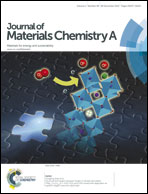Free-standing cobalt hydroxide nanoplatelet array formed by growth of preferential-orientation on graphene nanosheets as anode material for lithium-ion batteries†
Abstract
Cobalt hydroxide arrays/graphene nanosheets (Co(OH)2 array/GNSs) composites are formed by the growth of preferential-orientation versus basal planes of GNSs. Notably, the Co(OH)2 nanoplates, possessing special hexagonal morphology with the length of about 130 nm and average thickness of about 20 nm, stand vertically rather than lie flat on the surface of graphene sheets. More interestingly, the (001) crystal plane of Co(OH)2 is vertical to the graphene basal plane and forms strong covalent bond interaction (Co–C bond) with the graphene layer, which could be a driving force for the preferential growth of nanoarrays on graphene. Co(OH)2 array/GNSs composites exhibit not only high specific capacity, but also outstanding high-rate performance when used as anode materials for lithium-ion batteries. At the current density of 50 mA g−1, the reversible capacity is 976 mA h g−1 and remains at 1103 mA h g−1 after 50 cycles without any fading. At 500 and 1000 mA g−1, the reversible capacities can reach 696 and 496 mA h g−1, which are 71% and 51% of that at 50 mA g−1, respectively. Excellent electrochemical performance could be attributed to the array structure of Co(OH)2 as well as a synergistic effect between Co(OH)2 and graphene. Therefore, Co(OH)2 array/GNSs composites are expected to have potential applications in LIBs.


 Please wait while we load your content...
Please wait while we load your content...